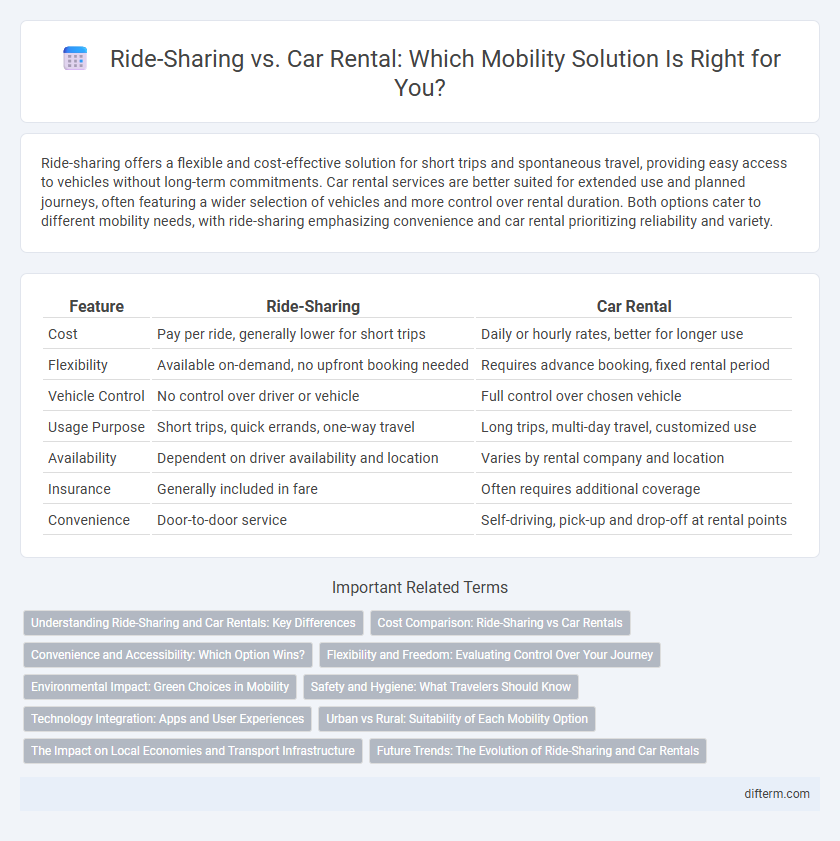Ride-sharing offers a flexible and cost-effective solution for short trips and spontaneous travel, providing easy access to vehicles without long-term commitments. Car rental services are better suited for extended use and planned journeys, often featuring a wider selection of vehicles and more control over rental duration. Both options cater to different mobility needs, with ride-sharing emphasizing convenience and car rental prioritizing reliability and variety.
Table of Comparison
| Feature | Ride-Sharing | Car Rental |
|---|---|---|
| Cost | Pay per ride, generally lower for short trips | Daily or hourly rates, better for longer use |
| Flexibility | Available on-demand, no upfront booking needed | Requires advance booking, fixed rental period |
| Vehicle Control | No control over driver or vehicle | Full control over chosen vehicle |
| Usage Purpose | Short trips, quick errands, one-way travel | Long trips, multi-day travel, customized use |
| Availability | Dependent on driver availability and location | Varies by rental company and location |
| Insurance | Generally included in fare | Often requires additional coverage |
| Convenience | Door-to-door service | Self-driving, pick-up and drop-off at rental points |
Understanding Ride-Sharing and Car Rentals: Key Differences
Ride-sharing services like Uber and Lyft provide on-demand, short-term transportation through mobile apps, connecting passengers with drivers using their personal vehicles, which offers flexibility and cost-effectiveness for urban mobility. Car rentals involve renting a vehicle from companies such as Hertz or Enterprise for longer durations, giving users full control over the vehicle without the need for a driver. Key differences include ride-sharing's focus on convenience and shared rides versus car rentals' emphasis on independent travel and extended use.
Cost Comparison: Ride-Sharing vs Car Rentals
Ride-sharing services often present lower upfront costs than traditional car rentals, especially for short trips or urban travel, due to no requirements for insurance or fuel payments. Car rentals typically incur higher fixed costs, including daily rental fees, insurance, and deposit requirements, making them more cost-effective for extended use or long-distance travel. Users should consider total trip duration, distance, and additional fees to determine the more economical option between ride-sharing and car rental.
Convenience and Accessibility: Which Option Wins?
Ride-sharing services offer unmatched convenience by providing on-demand transportation without the need to park or maintain a vehicle, ideal for urban commuters seeking instant access. Car rentals provide greater accessibility for longer trips, offering a variety of vehicle types and extended usage that ride-sharing cannot accommodate efficiently. In terms of accessibility and ease of use, ride-sharing dominates short-distance, spontaneous travel, while car rentals excel in flexibility for planned, extended mobility needs.
Flexibility and Freedom: Evaluating Control Over Your Journey
Ride-sharing services offer convenience but often limit control over departure times and routes, while car rentals provide greater flexibility to customize your travel schedule and destinations. Renting a car allows travelers to enjoy freedom in exploring off-the-beaten-path locations without reliance on driver availability. The level of autonomy in managing your journey significantly impacts the overall mobility experience between these two transportation options.
Environmental Impact: Green Choices in Mobility
Ride-sharing significantly reduces carbon emissions by maximizing vehicle occupancy and minimizing the number of cars on the road, leading to lower overall environmental impact compared to traditional car rentals. Car rentals tend to increase vehicle usage and emissions since each trip often involves a separate vehicle, contributing to higher greenhouse gas output. Choosing ride-sharing services aligns with sustainable mobility goals by promoting efficient resource utilization and reducing urban air pollution.
Safety and Hygiene: What Travelers Should Know
Ride-sharing services implement rigorous background checks, real-time GPS tracking, and contactless payments to enhance passenger safety and minimize health risks. Car rental companies prioritize vehicle sanitation through deep cleaning protocols, including disinfecting high-touch surfaces before each rental period. Travelers should evaluate safety measures and hygiene standards of both options to make informed decisions during their journeys.
Technology Integration: Apps and User Experiences
Ride-sharing platforms leverage advanced mobile apps with real-time GPS tracking, dynamic pricing algorithms, and seamless payment systems to enhance user convenience and operational efficiency. Car rental services are increasingly integrating app-based features such as keyless vehicle access, instant booking confirmations, and personalized vehicle selection to improve customer experience. The technological advancement in ride-sharing apps typically offers more fluid user interfaces and quicker transaction times compared to traditional car rental applications, promoting greater user engagement and retention.
Urban vs Rural: Suitability of Each Mobility Option
Ride-sharing services excel in urban areas due to high population density, frequent demand, and extensive coverage, providing cost-effective and flexible transportation options. Car rentals suit rural regions better, offering personal vehicle control and longer travel range where public transport and ride-sharing availability are limited. Urban residents benefit from ride-sharing's convenience and lower expenses, while rural users rely on car rentals for accessibility and independence.
The Impact on Local Economies and Transport Infrastructure
Ride-sharing services stimulate local economies by creating flexible employment opportunities and increasing demand for urban transportation networks, leading to enhanced public transit investments and infrastructure upgrades. Car rental companies contribute by attracting tourists and short-term visitors who often spend more in local businesses, supporting hospitality and service sectors. Both models influence traffic patterns and parking infrastructure, necessitating adaptive urban planning to accommodate fluctuating vehicle usage and curb space management.
Future Trends: The Evolution of Ride-Sharing and Car Rentals
Future trends in mobility indicate a significant shift as ride-sharing platforms incorporate autonomous vehicles and AI-driven route optimization to enhance efficiency and user experience. Car rental services are increasingly adopting subscription models and electric vehicle fleets to meet growing environmental concerns and consumer demand for flexibility. Integration of smart city infrastructure and real-time data analytics is expected to blur the lines between ride-sharing and car rentals, creating seamless, multimodal transportation options.
ride-sharing vs car rental Infographic

 difterm.com
difterm.com